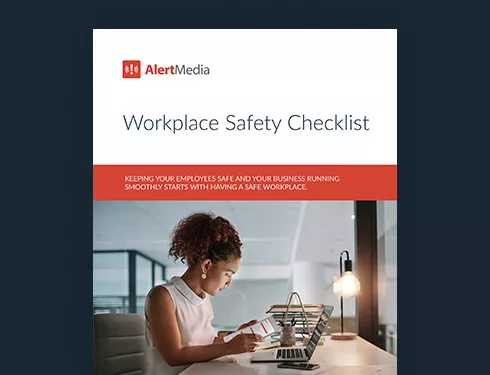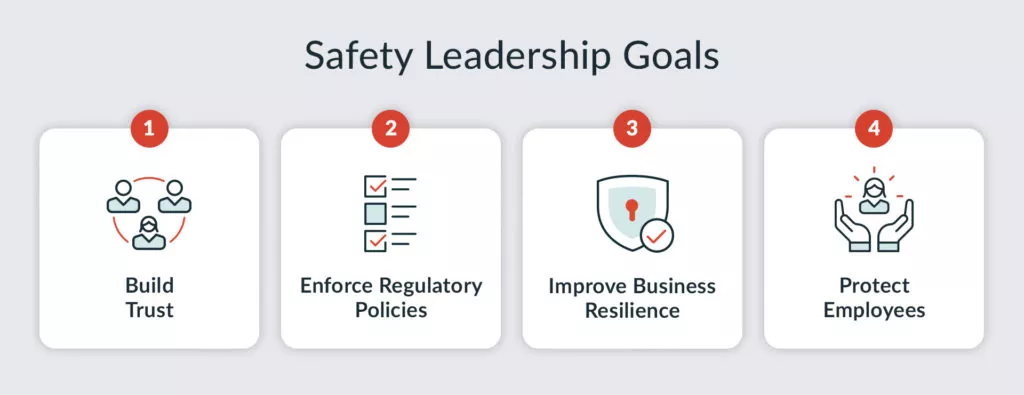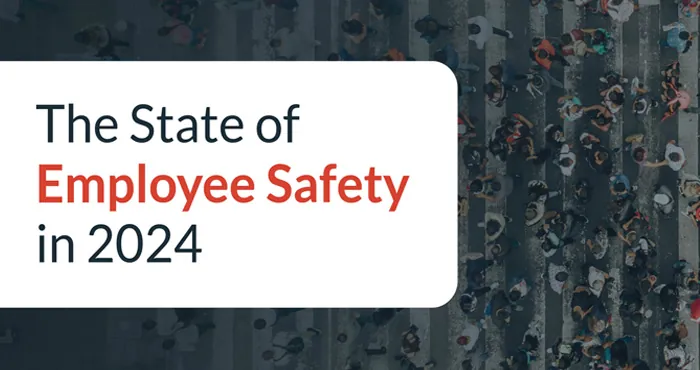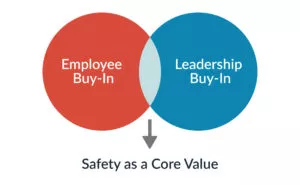![5 Keys to Strong Safety Leadership [+ Company Buy-in]](https://www.alertmedia.com/wp-content/uploads/2022/05/Blog-SafetyCultureBuyIn-Leadership-1024x536.jpg)
5 Keys to Strong Safety Leadership [+ Company Buy-in]
Safety leadership is key to the success of a business, but it’s not always simple. Learn how to be a stronger safety leader and how to get the rest of your team to buy into the importance of safety.

As a safety leader, you protect the security, performance, and resilience of your organization every day. But that can be even more challenging than it sounds.
Too often, safety leadership feels like an uphill battle. Maybe it seems like for every accident prevented or injury avoided, there is a slip-up in process or a new regulation that upheaves your policies. Maybe you struggle to keep your employees engaged and following safety protocols, or you have to strain to get leadership participation.
Your job is ultimately to protect your company and employees from harm. Here are a few key ways you can strengthen your initiatives to fulfill your duty and inspire and engage the rest of your company and grow your safety culture. We’ve also included some tips on how to get management and employees to buy into your safety programs so you face fewer hurdles.
The 4 Safety Leadership Goals
Good safety leadership starts with understanding your ongoing commitment to building and maintaining a positive safety culture throughout your organization. There are always contributing factors beyond your control, such as weather patterns or outside agents. But the things you can influence will inform your leading safety goals.

Build trust
Effective safety leadership relies on trust. Your company executives need to trust you in order to grant funds or approve company policies. And without trust, employees are less likely to follow instructions or procedures. Your people’s confidence is foundational to all of your safety leadership goals and initiatives.
Uphold regulatory policies
Safety leaders act as small-scale regulatory enforcers—like agents for OSHA. You make sure that the company is following all local, state, and federal laws when it comes to occupational safety, and you work to prevent incidents through proactive efforts. You also work to protect your company from liability by performing investigations into accidents and health and safety hazards.
Improve business resilience
One foundational goal is to be able to bounce back from and even improve after a critical event. The longer your business stalls or struggles, the higher the chance of continued damage or secondary hazards. Actively work to strengthen the resilience of your company so that incidents pose less harm to employees and business continuity.
Protect employees
Above all else, this is what safety leadership is about: protecting employees from harm. With this goal in mind, your decisions are based on upholding the company’s duty of care and preventing undue injury or illness for employees. You are the advocate when it comes to policies, equipment, and efforts, and you enable workers to perform their jobs in a safe environment.
Mark French—Senior Health, Safety, and Environmental Manager at Dalkia Energy Solutions—looks at safety leadership this way: “Dalkia uses the term ‘zero harm’ to describe their safety efforts. It is a wonderful phrase that sums up what I feel my goal is as a safety professional… The real mission is to prevent any harm to my team, to the environment, and to the clients and communities that we service. Dalkia has a distinct focus on culture, not just on safety. It is a culture that is focused on people which means empowerment, inclusion, and a safe place to work.”
All of these goals serve as guiding points to improve your safety leadership skills over time. Now, let’s look at five active tips for how you will work toward these goals to be a strong, effective safety leader.
How To Be an Effective Safety Leader
1. Focus on growth, not blame
Prioritize learning and growing from accidents. While it might seem like a catch-all approach, firing someone responsible for a safety breach without a thorough investigation may discourage trust.
In a transparent and cooperative way, use incidents as learning opportunities. Conduct investigations into what went wrong and adapt your procedures if you find ways to prevent similar issues. This will create a positive safety culture instead of relying on fear to avoid harm.
Safety management:
-> Blaming
-> Discipline
-> Clipboard walks
-> Fishing for faults
-> Checklists & formsBetter safety management:
-> Caring not scaring
-> Listening and Learning
-> Feedback not criticism
-> Engaging and Coaching
-> People before Paperwork— david cant ~ CFIOSH 👷♂️ (@davidgcant) May 15, 2022
2. Make safety easy
Create a workplace where it is easy to prioritize safe practices. Here are a few ways you can do that:
- Make PPE and safety equipment easily accessible, and inspect them regularly for damage
- Provide easy-to-understand explanations of safety policies, and offer frequent demos or run drills on common or important procedures
- Require mandatory safety training at regular intervals for all employees
You want safety to be the easiest option when employees are working so there are no hesitations or excuses about it being too difficult.
3. Communicate frequently
Set up consistent and frequent feedback loops with both leadership and employees. Setting a precedent of good communication can ensure that your critical communications, such as warnings of safety hazards or alerts during an emergency, are taken seriously. You can use a two-way communication system to do safety wellness checks with employees or solicit safety requests or needs.
4. Create a “safe space” for safety
Ensure that employees will report hazards early by creating a safe place for them to share their observations and experiences. People need to feel comfortable bringing safety issues to you before a risk becomes an accident. Consider hosting office hours or conducting regular one-on-one meetings with employees where they know you will take their concerns seriously without unnecessary repercussions. This will develop your trust and foster positive relationships.
5. Be a safety advocate
Set a good example for the rest of the company by always advocating for safety above all else. Whether you are talking to board members or training new employees, emphasize the priority of workplace safety above all else, including speed and profit. Establishing this core value in your company will help set expectations about how things should be done.
How To Get Safety Buy-in
Being a strong, effective leader can make or break your safety efforts. But even the best safety leader can struggle if your management or employees aren’t bought into safety as a top priority. Here are a few tips for getting safety buy-in at your organization.
Leadership buy-in
When you seek buy-in from management, you may be tackling considerations outside of your control. But you can still work to inspire a perspective shift. Even when safety procedures are costly, the right evidence can highlight the long-term value of prioritizing a safer workplace.
- Use hard data— Pull hard statistics on safety hazards, such as studies on tired driving or rates of fatalities, that relate to your business in order to show the direct effect that safety can have. You can also use expense data on worker compensation for injuries or illnesses to influence senior leaders.
- Bring up brand reputation— Address how safety efforts will improve brand reputation, or show how the brand’s reputation may have suffered in the past from an incident that could have been prevented. It can also help to have data on how reputation has influenced revenue.
- Use examples of previous incidents— Use previous investigations or reports from accidents to show how they affected the long-term growth of the company. They can also clearly show where security efforts need to be improved.

Employee buy-in
Your employees may not have much influence over policies, but they are the ones on the front lines of workplace safety. With their well-being on the line, most employees understand the importance of safety, but they may still resist changes to safety rules if they might add to their workload or increase the chance of disciplinary action. Here is how to present your ideal culture of safety to employees.
- Incentivize safety— Use rewards or even safety awards to incentivize employees to follow all safety practices and integrate safe behaviors into their everyday work. These rewards will encourage a safe and positive work environment.
- Show benefits clearly— Demonstrate exactly how safety programs can improve the lives of employees. Make sure to emphasize how this will protect them and prevent work stoppages so that there are fewer interruptions and lost wages.
Leading Your Organization to Safety
As a strong safety leader, you have the power to go beyond just protecting your organization. You are the difference between a company that survives and a company that thrives. Your employees are relying on you to keep them safe, and your management team relies on you to prevent business-crippling accidents. But you don’t have to do any of it alone.
AlertMedia’s mass notification software with built-in threat intelligence makes every part of your job easier, from sending out emergency alerts to tracking approaching threats. Armed with the right technology, you can rest assured that your company has the best chance of mitigating harm and responding quickly and effectively to both internal and external threats. Learn more about how AlertMedia can level up your safety leadership here.





